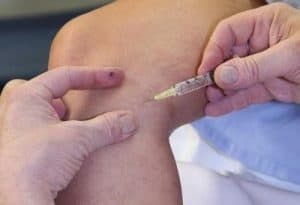What is Sclerotherapy?
Sclerotherapy is a minimally-invasive and effective method used for the elimination of spider veins. If has been used in one form or another for 150 years. While the idea might be over a century old, new techniques, compounds, and imaging testing make it more beneficial than ever before.
During the procedure, a solution is injected into the unsightly veins. This solution, called a sclerosant, like Asclera, triggers a reaction in the targeted vein. The superficial vein becomes irritated and inflamed. As a result of inflammation, the vein closes itself off from the circulatory system and dies. Over the course of a few weeks, the body reabsorbs the dead veins. While a needle is used to inject the sclerosant into the veins during sclerotherapy, most patients report little to no discomfort. Most sessions last around thirty minutes.
Sclerotherapy for Treating Spider Veins
As mentioned above, sclerotherapy is a widely used and safe treatment for reducing the appearance of spider veins. Spider veins are the smaller cousin of varicose veins. Just like varicose veins, spider veins are superficial veins that can be seen through the skin. They are, however, smaller and do not push the skin out, like raised varicose veins. They are most typically purple or red and are most common on the legs and thighs. Spider veins can also be found on the face with some frequency. When on the face, they are treated with laser/light therapy.
Sclerotherapy: Results and Recovery
Modern sclerotherapy has been performed for around eighty years. Over that time period, it has proven itself to be a highly effective tool in the treatment of spider veins. The results of longitudinal studies find that those who undergo sclerotherapy treatment see a 50 to 80% reduction in the appearance of spider veins. Personal data suggests the same success rate. If you are considering sclerotherapy, you should be aware that maximum results may not be noticeable for several weeks after treatment. In some cases, bruising will occur at the injection site. It is not uncommon for some patients to require multiple sclerotherapy sessions.
What Makes You a Good Candidate For Sclerotherapy?
Unfortunately, sclerotherapy isn’t for everyone; some people aren’t candidates, which is why your doctor might advise against treatment. Your doctor will consult with a dermatologist before beginning your treatment, and they will determine whether it is appropriate for you.
If you are pregnant, they may reject you since it is harmful to the fetus health. You can return for treatment after the three months have passed since your delivery.
You may also be denied if you have a blood clot. Because the procedure may cause damage to your veins.
Breastfeeding mothers are also not permitted.
If you have an illness like cancer or a difficult ailment, treatment can be difficult.
Risks and Side Effects
You may have various side effects after sclerotherapy. Milder side effects, such as itching, may last for one or two days after surgery. You can also observe a ring of increased red around the injection site.
These should go away in a few days. It’s also possible to get bruising around the injection site, which can last for days or weeks.
Sclerotherapy also carries the following risks
1. Lines and Brown Spots
Brown streaks or patches may appear near the vein. They normally go away after three to six months, although they could last indefinitely.
2. Neovascularization
It is possible for new, tiny blood vessels to form at the site of sclerotherapy treatment. These small veins may occur days or weeks after surgery, but they should go away on their own in three to twelve months without treatment.
How To Get Ready For A Sclerotherapy Treatment?
Before a Sclerotherapy treatment, there are several steps that individuals can take to prepare themselves and ensure the best possible results.
- Talk To Your Doctor
It is important to inform the medical professional of any medical conditions, allergies, or medications that you are currently taking. This will help the provider to determine if you are a suitable candidate for the treatment and to tailor the treatment to your individual needs.
- Avoid Tight Clothes
It is recommended to wear loose and comfortable clothing on the day of the procedure. This will make it easier for the medical professional to access the affected veins and to apply pressure to the injection sites after the treatment.
- Avoid Cosmetics and Lotions
Avoid applying lotion or cream to the legs on the day of the treatment, as this can interfere with the absorption of the sclerosing solution.
- Avoid Blood thinning medicines
It is important to avoid taking blood-thinning medications or supplements such as aspirin or ibuprofen for a few days before the treatment, as these can increase the risk of bleeding or bruising at the injection site.
- Do Not Smoke
It is recommended to avoid smoking and drinking alcohol for at least 24 hours before the treatment, as these can interfere with the healing process.
By following these guidelines, individuals can ensure a safe and effective sclerotherapy treatment with minimal side effects. It is important to discuss any concerns or questions with the medical professional before the procedure.
How many Sclerotherapy sessions are important?
The number of Sclerotherapy sessions required depends on the severity of the condition being treated, as well as the individual’s response to the treatment. Some individuals may require only one session, while others may require multiple sessions spaced several weeks apart to achieve the desired results.
Just call 724-987-3220 today!

